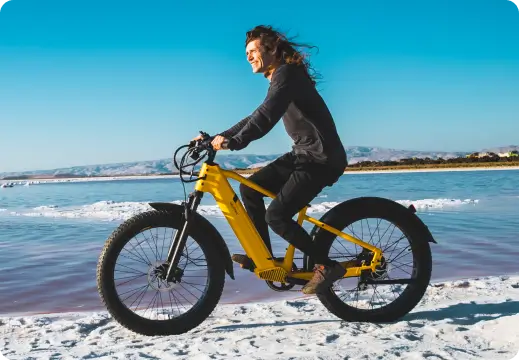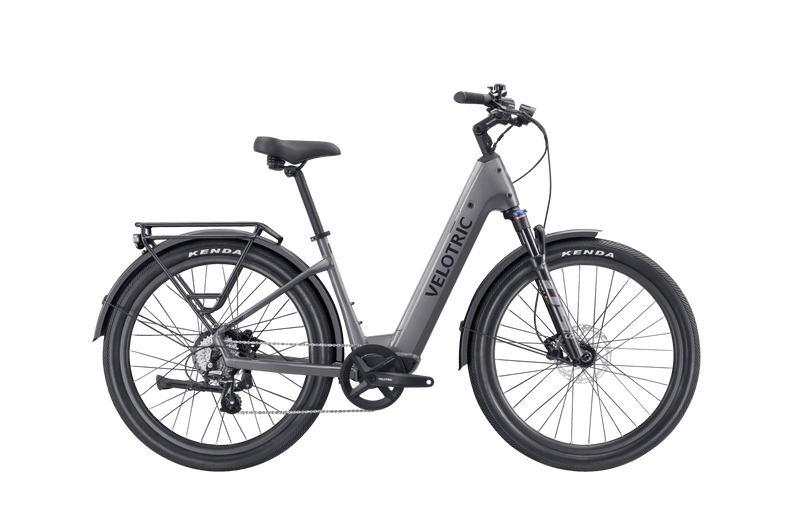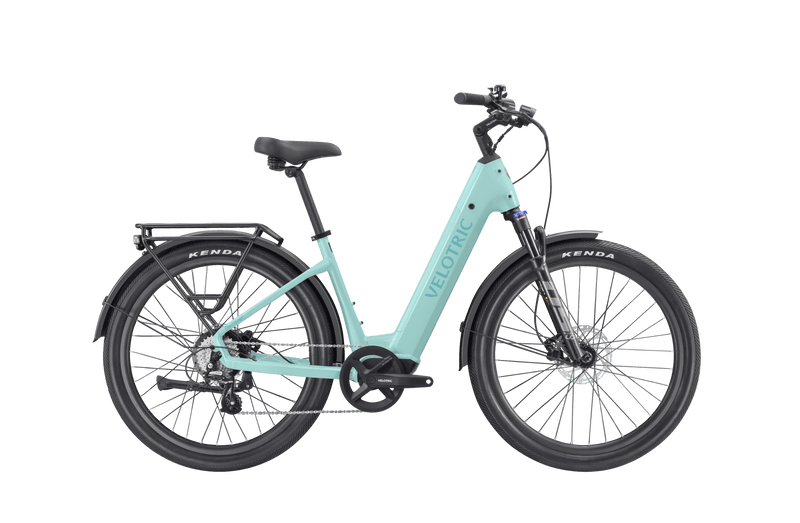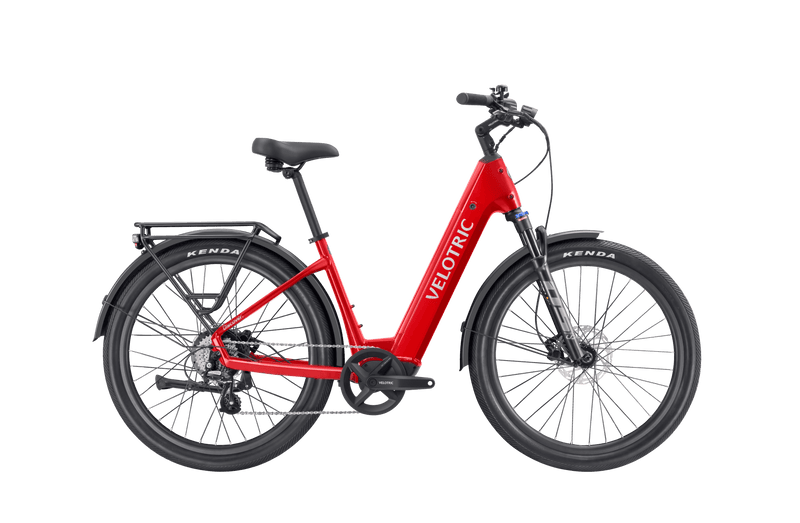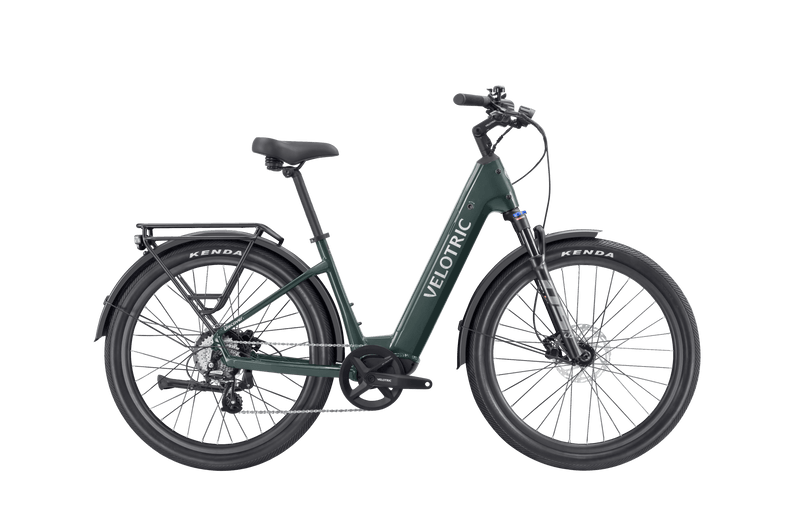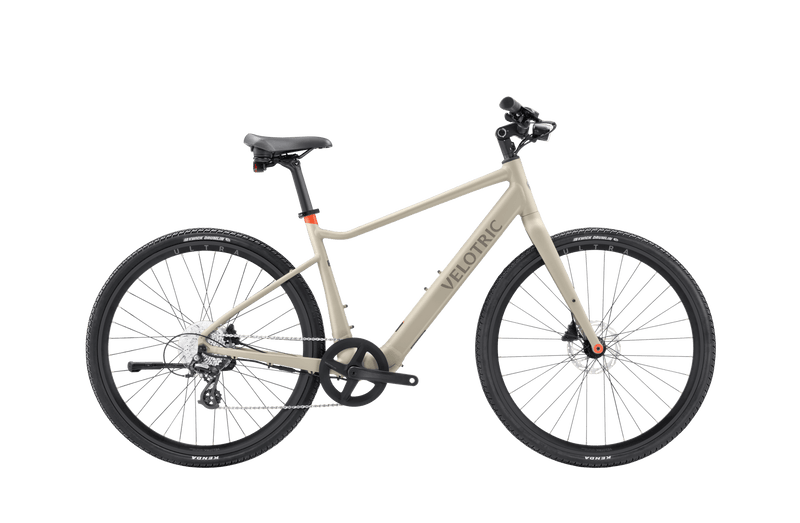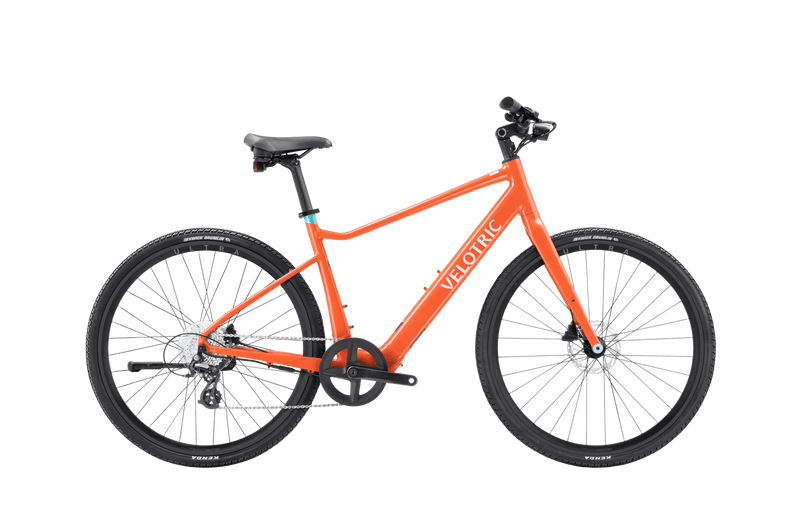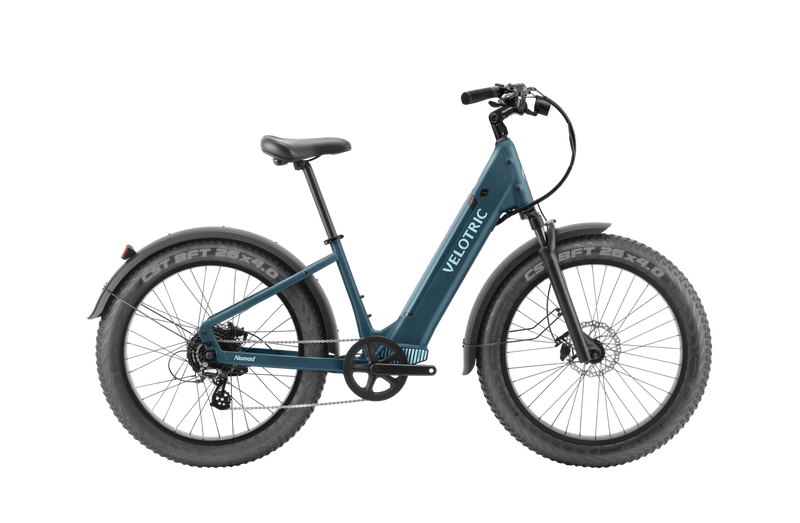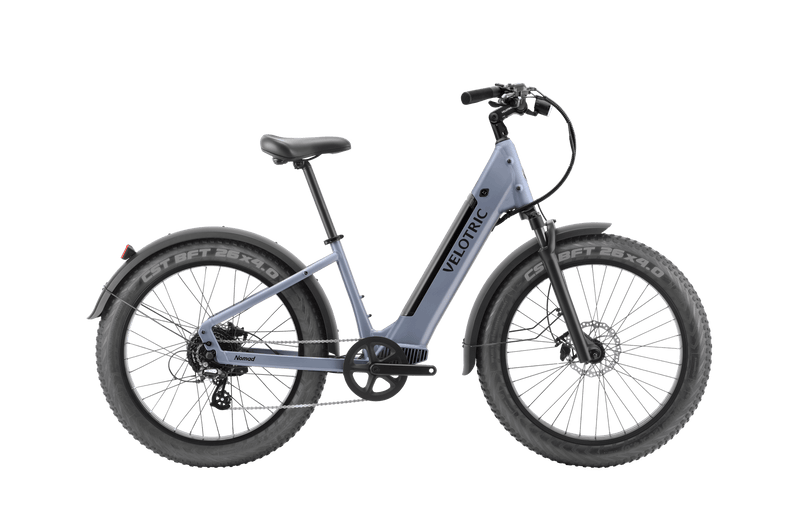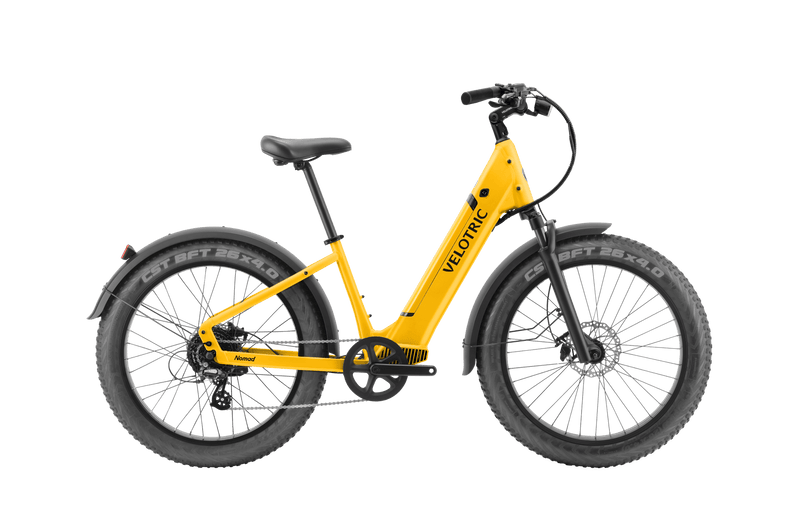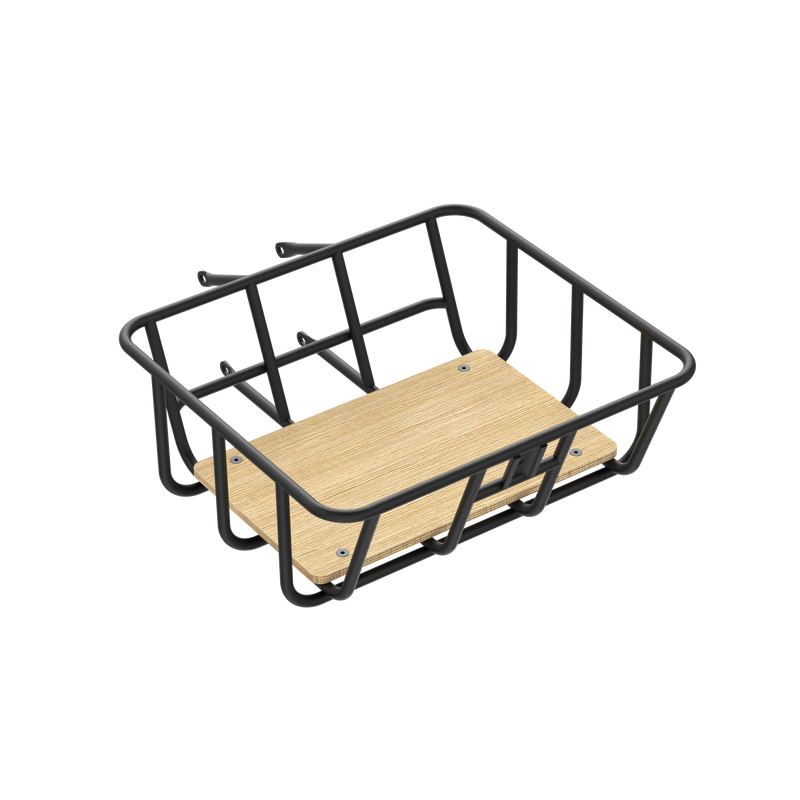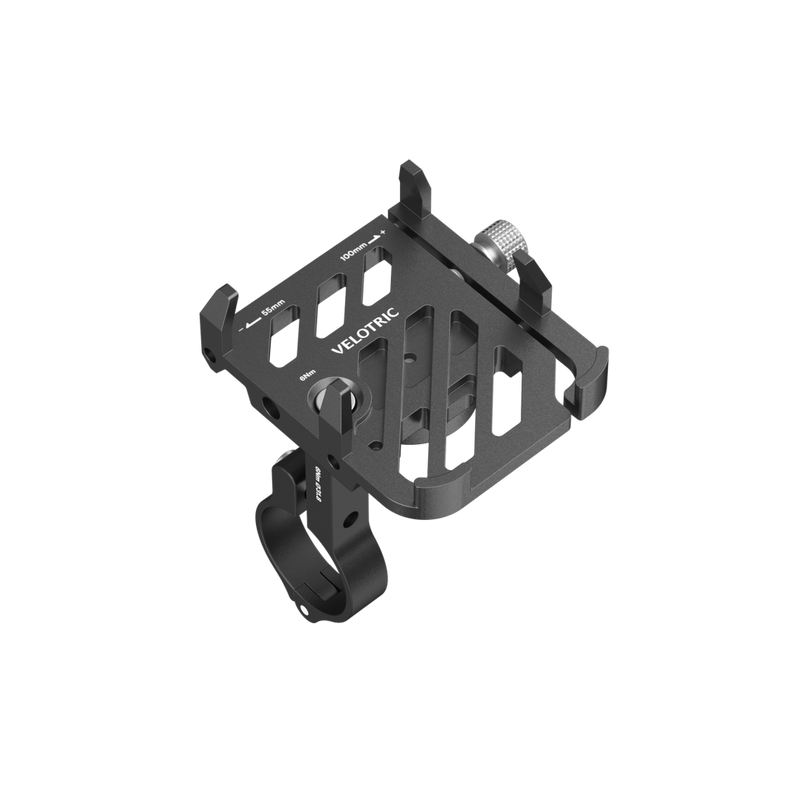The e-bike business is booming, with electric bikes even outselling electric cars in recent years. What’s with the hype?
E-bikes offer many benefits: They’re versatile and can be used for exercise or everyday commuting. They’re also cost-efficient and environmentally friendly. You don’t have to worry about gas prices!
If you’re thinking of hopping on board the e-bike bandwagon, you probably have some questions. This beginner’s guide has you covered.
In this guide to e-bikes, we explain everything from how e-bikes work to what types of e-bikes you can choose — and how to choose the right e-bike. Let’s get to it.
What is an e-bike?
An electric bicycle is similar to a traditional two-wheeled bicycle, consisting of a frame, saddle (the seat), handlebars, a gear system, brakes, and pedals. You push the pedals with your feet to turn the wheels and move forward. However, an e-bikealso has an electric motor, which can help as you pedal.
Depending on the e-bike classification (more on e-bike classes below), the e-bike motor can provide two types of assistance. First, a pedal assist system (PAS) engages and provides support when you’re pedaling. Second, a throttle assist system propels the bike forward even when you aren’t pedaling.
You can select the level of electric assist you want, adjusting how much help you get. For example, you might want to engage the pedal assist at a higher level when tackling a tough hill.
Thanks to this adjustable assistance, e-bikes provide a workout while allowing you to travel faster and farther and for longer since you can engage the pedal or throttle assist when you get tired.
How do e-bikes work?
The heart of the e-bike is the motor. The motor powers the PAS and — if the bike has throttle assist (not all do) — the throttle assist system. There are different types of electric bike motors, including mid-drive motors, geared hub motors, and direct-drive hub motors. Learn more about the differences between e-bike motors.
Regardless of how it works mechanically, an e-bike motor is powered by the bike’s battery. Battery type and capacity vary between e-bikes. For example, Velotric’s e-bikes are equipped with a 48V 14.4Ah lithium battery.
You can remove the e-bike’s battery from the bike and recharge it using a designated charger that you plug into the wall. Once the battery is charged, you can reinsert it into the e-bike, and you’re ready to ride.
Battery life — exactly how long the battery will last before it drains — depends on the e-bike. For example, Velotric’s Discover 1 e-bike has a range of 65 miles. Meanwhile, the Nomad 1 — a fat tire bike that is a bit heavier — has a 55-mile range.
However, the range (how long the battery lasts) also depends on factors like weight and cycling style. For example, if you engage pedal assist mode at a high level while going up hills, you’ll drain the battery faster than if you’re coasting down hills without pedal assist.
E-bike classes explained
E-bikes are classified into three main categories, which are determined by motor power, whether the bike offers pedal and/or throttle assist and maximum speeds. If you know the class of e-bike, you’ll know what to expect in terms of performance.
Another reason it’s important to consider e-bike classes is that the laws governing the use of e-bikes depend on the class. For example, you might not be allowed to ride a Class 3 e-bike in the same areas you’re allowed to ride a Class 1 e-bike.
These rules and regulations vary by state, and many states have their own e-bike classifications (or lack thereof). For example, while California has legislation for three classes of e-bikes, Pennsylvania doesn’t have a tiered e-bike class system and just has rules governing e-bikes in general.
That said, there are some widely accepted e-bike class definitions. We outline these general standards below.
Class 1 e-bikes
A Class 1 e-bike is also known as a pedelec because it only moves forward when you’re pedaling. Class 1 e-bikes have pedal assist, but no throttle assist and can’t exceed speeds of 20 miles per hour (mph).
Class 1 e-bikes are generally allowed in the same spaces as traditional bikes, like bike paths and bike lanes (but regulations depend on the local government ordinances).
Class 2 e-bikes
Class 2 e-bikes have pedal assist and throttle assist. This means they can move forward even when you aren’t pedaling. Class 2 e-bikes usually can’t go faster than 20 mph.
Most jurisdictions allow Class 2 e-bikes on traditional bike paths and lanes.
Class 3 e-bikes
Class 3 e-bikes are a bit faster and can go up to 28 mph. They’re often equipped with a speedometer to show the speed (some states, like California, even require this). Class 3 e-bikes are usually allowed on roads and bike-only shoulder lanes. However, because they’re so powerful, they’re generally not permitted on standard bike lanes, paths, or trails.
Common types of e-bikes
In addition to different classes of e-bikes, there are also e-bike types suited to different purposes. Here’s a quick rundown of some common types of e-bikes.
Commuter e-bikes
Commuter e-bikes are intended for everyday use — for example, getting to and from work. They have tires that are about 28 to 42 millimeters (mm) in width, a little thicker than those of a performance road bike (we’ll talk about those below).
While this means they aren’t as speedy, the larger tires provide more stability and better traction. This can be a big help when cycling on slick surfaces.
Velotric’s Discover 1 is an example of a commuter e-bike you can use to get from point A to point B in urban areas.
Fat tire e-bikes
Fat tire electric bikes are (as the name suggests) equipped with wider-than-average tires. Fatter tires offer greater stability and puncture protection, making them ideal for cycling on unpaved surfaces like gravel and dirt. However, fat tires produce more friction on the riding surface, slowing them down.
Velotric’s Nomad 1 is an example of a fat tire bike well-suited for use on e-bike trails. Learn more about the benefits of fat tire bikes and why you might want to get one.
Mountain e-bikes
If you dream of tackling the rugged outdoors on two wheels, an electric mountain bike (eMTB) is for you. These bikes have even fatter and wider tires than a fat tire bike like the Nomad 1. They’re also more rigid and offer a lot of traction, improving grip on surfaces like rocks, grass, and sand.
Mountain e-bikes may also have more robust suspension systems. The suspension in an e-bike is what absorbs shock. Since mountain cyclists may jump over roots and other obstacles, they need a stronger suspension system.
Performance road e-bikes
Performance road bikes are built for speed. When you picture cyclists in road races, this is likely what they’re using. These bikes have super-thin tires, usually no more than 1 inch wide — about 23 to 25 mm.
Because they don’t have a lot of contact with the road, these bikes don’t create a lot of friction as they move ahead. This means cyclists can go faster. However, road bikes lack tread and traction, which can make them a less appealing choice for everyday users who prioritize practicality and safety over speed.
How to choose an e-bike: What to consider
When buying an e-bike, the class and type — as described above — are two key points to consider. But that’s not all you need to think about.
Here are a few more points to remember when buying an e-bike.
E-bike price
One reason for the growing popularity of e-bikes is that they’re becoming more affordable.
Sure, you can get a high-end e-bike for upward of $6,000. But there are good-quality e-bikes available at a third of the cost. For example, Velotric’s e-bikes start as low as $1,000.
E-bike type
The right type for you depends on your purpose. If you’re going to be cycling to and from work, for example, a commuter bike could be right.
If you want an e-bike you can transport easily, a folding bike is a great pick. It’s foldable, so you can even bring it on public transportation.
In addition to the type of e-bike, you also want to consider the type of frame. For example, step-through (step-thru) bike frames require you to lift a leg up and over the bike to get on.
Meanwhile, step-through bike frames can be mounted by stepping into the frame. Learn more about the differences in bike frames.
Velotric’s Nomad 1 and Discover 1 come in step-through and high-step models. The high-step is suitable for cyclist heights from 5’6” to 6’9”, while the step-through is suitable for cyclists from 5’1” to 6’4”.
Special features to consider
You might be interested in certain features or accessories you can purchase as add-ons for your e-bike. Here are some items to consider:
- Storage rack. If you want added storage for your e-bike — for example, because you ride it to work or school and have a bag to carry — an additional rear rack can come in handy.
- Lights. Some e-bikes come equipped with lights, while others sell them separately. Rear and front lights improve visibility and are valuable safety additions.
- Reflectors. Reflectors are another add-on that can help improve visibility, especially at night. They make it easier for cars, pedestrians, and cyclists to see you.
- Fenders. Fenders help protect against splashback when driving through mud and water. They can help keep your clothes clean. For example, they’re a good investment if you plan to cycle to work.
E-bike FAQs
Do you still have questions about e-bikes? We cover some of the most commonly asked queries below.
How far can e-bikes ride on a single charge?
The distance an e-bike can travel on a single charge depends on multiple factors, including its battery capacity, the size of the bike, and the cyclist’s weight and riding style.
Velotric’s Discover 1 e-bike can go 65 miles on a single charge, for example, while the heavier, fat tire Nomad 1 e-bike can go up to 55 miles on a single charge.
The stress the cyclist puts on the e-bike motor also determines how far the e-bike can go. You’ll be able to go farther if you’re cycling on flat terrain with minimal pedal assist use than you would if cycling uphill and engaging maximum pedal assist.
How fast can e-bikes go?
An e-bike’s maximum speed depends on the power of the motor. You can figure out the e-bike’stop speed by looking at its classification. Class 1 and Class 2 e-bikes can’t go more than 20 mph, for example, while Class 3 e-bikes can go up to 28 mph.
That said, these are general industry standards, and there are exceptions. For example, New York State classifies a Class 3 e-bike as having a maximum speed of 25 mph (instead of 28 mph).
Can e-bikes go uphill?
Yes, you can use an e-bike to go uphill. In fact, one of the biggest advantages of an e-bike is that you can get help when climbing inclines, saving your strength and alleviating the burden on your leg muscles.
Velotric’s Discover 1 and Nomad 1 e-bikes allow for effortless cycling even when going eight degrees uphill.
Is it OK for e-bikes to get wet?
Yes, e-bikes can get wet. However, avoiding cycling through puddles is advisable, as the splashback can get into the e-bike battery and motor, potentially causing corrosion.
The e-bike’s manufacturing quality also helps determine how robust it is. For example, Velotric’s e-bikes are IPX6-grade waterproof.
How long does it take to charge an e-bike?
An e-bike’s charging time depends on the battery capacity and the manufacturer’s make and model. For reference, Velotric’s e-bikes charge 100% in only six hours.
Find the best Velotric e-bike for you
You might think that the best electric bikes have to be the most expensive ones. Think again! Velotric offers high-quality yet cost-effective e-bikes.
Our Discover 1 is best for urban riding, with a 500/900-watt motor. If you want to go off-road, try our fat tire bike, the Nomad 1, with a 750/1,200-watt motor.
Both e-bikes come with five-level pedal assistfunctionality plus throttle assist. Our e-bikes are also equipped with Shimano hydraulic disc brakes, fenders, and lights, improving comfort and safety.
With Velotric, you can pick the e-bike that best fits your needs and tailor it to your style. Choose from a step-thru or step-over frame to accommodate your height and cycling style.
Ready to try a Velotric bike? Find a bike shop near you to book a test ride today.






































